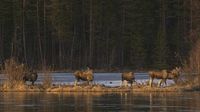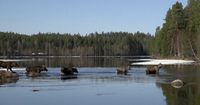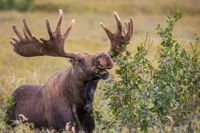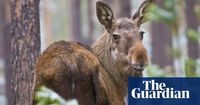Millions of viewers around the world are tuning in to witness the annual spectacle of Sweden's "The Great Moose Migration," a unique slow TV livestream that captures the serene journey of moose as they trek across the Ångerman River toward their summer grazing grounds. The event, which began on April 15, 2025, is set to run for 20 days, showcasing the natural beauty of Sweden while offering a rare glimpse into the daily life of the country's iconic wildlife.
The show, known in Swedish as "Den stora älgvandringen," first aired in 2019, attracting nearly a million viewers. Since then, its popularity has skyrocketed, with viewership reaching 9 million in 2024, according to the Associated Press. This year, the livestream kicked off a week early due to unseasonably warm weather, allowing viewers to enjoy the early movement of the moose.
Ulla Malmgren, a dedicated viewer, prepared for the event by stocking up on coffee and meals so she wouldn't miss a moment. "Sleep? Forget it. I don’t sleep," she exclaimed, highlighting the commitment of many fans who are ready to immerse themselves in the experience. Malmgren is part of a Facebook group of over 76,000 members who share their excitement and support for the moose as they embark on their journey.
William Garp Liljefors, another enthusiastic fan, admitted that he has been late for school because he couldn't tear himself away from the livestream. "I feel relaxed, but at the same time I’m like, ‘Oh, there’s a moose. Oh, what if there’s a moose? I can’t go to the toilet!’" he shared, capturing the blend of anticipation and tranquility that characterizes the viewing experience.
The Great Moose Migration is not just a show; it’s a phenomenon that reflects a growing trend in slow television, which encourages viewers to engage with nature at a leisurely pace. This trend began with Norway's public broadcaster NRK in 2009, when they aired a seven-hour train journey. Since then, slow TV has expanded to include various formats, including the moose migration, which consists of 34 cameras capturing the action live without edits or narration.
According to Annette Hill, a professor of media and communications at Jönköping University, slow TV has a unique appeal because it allows viewers to relax and connect with nature in a way that feels authentic. "It becomes, in a strange way, gripping because nothing catastrophic is happening, nothing spectacular is happening," she explained. "But something very beautiful is happening in that minute-by-minute moment."
Johan Erhag, the project manager for the livestream, noted that the moose have followed the same migration path for thousands of years, making it easier for the crew to set up their equipment. Over 20,000 meters of cable and 26 remote cameras, along with seven night vision cameras, have been strategically placed along the route to capture the moose as they swim across the river and traverse the forests.
Erhag emphasized the significance of the moose in Swedish culture, stating that there are approximately 300,000 moose roaming the country's woods. Known as the "King of the Forest," a bull moose can reach up to 210 centimeters (6 feet 10 inches) at shoulder height and weigh around 450 kilograms (992 pounds). Despite their size, these majestic creatures are often elusive, which adds to the allure of watching them in their natural habitat.
As the livestream progresses, viewers eagerly await the moment when the first moose appears on camera. SVT even sends push notifications to subscribers to alert them when a moose is spotted. This excitement is palpable in the livestream's chat, where fans cheer on the moose, creating a sense of community among viewers. "I would actually like to be a little fly on the wall in every household that watches the moose migration," Malmgren said. "Because I think there is about a million people saying about the same thing: ‘Go on! Yes, you can do it!’"
The captivating experience of watching the moose migration has led to a devoted following. Fans like Arne Nilsson, who moderates a Facebook group dedicated to the event, spend hours online discussing the migration and sharing updates with fellow enthusiasts. "I didn’t really think it would hit. I thought it would be ridiculous," Nilsson admitted, reflecting on the show's unexpected success.
The serene landscapes captured during the livestream also play a crucial role in its appeal. Viewers are treated to stunning visuals of forests, rivers, and wildlife, creating a calming atmosphere that contrasts sharply with the fast-paced nature of modern media. As Marianne Hauger, another fan, noted, the chat community provides a welcome distraction from the stresses of everyday life. "When you’re in this chat, you forget that there are bad things in the world," she said.
As the Great Moose Migration continues until May 4, 2025, viewers around the world will remain glued to their screens, captivated by the slow, majestic journey of these remarkable animals. With each passing day, the livestream not only showcases the beauty of Sweden's natural landscapes but also highlights the deep connection between humans and the wildlife that shares our planet.
In a world filled with distractions, The Great Moose Migration serves as a reminder of the tranquility that can be found in nature, encouraging viewers to slow down and appreciate the simple beauty of life.








